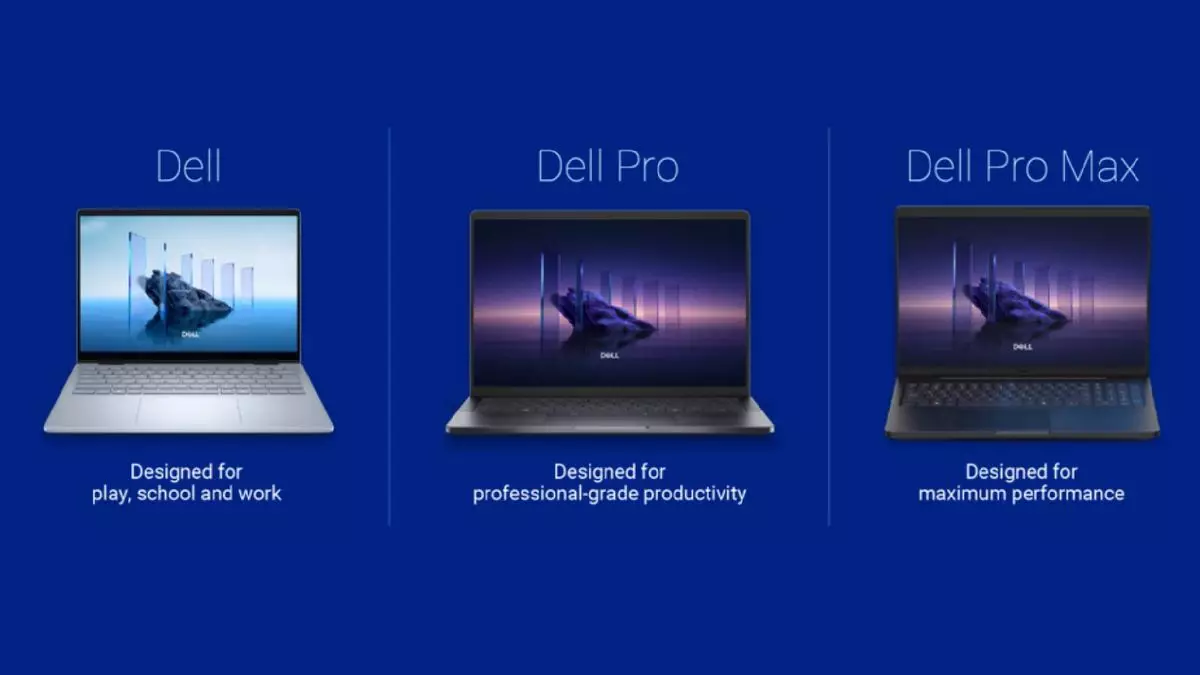In an era where consumer technology is becoming increasingly saturated, Dell has taken bold steps to reshape its branding strategy. This recalibration aims not only to clarify the user experience but also to resonate with the evolving preferences of today’s consumers. The firm has streamlined its PC product tiers into three accessible categories: Dell, Dell Pro, and Dell Pro Max. This article delves into the implications of this branding adjustment and explores whether it genuinely addresses the complexities faced by tech shoppers.
The New Brand Structure: Clarifying Choices
Dell’s recent simplification of its product offerings exemplifies a shift towards more coherent branding. In replacing the Inspiron and related labels, the company has pivoted to a triad system designed to cater to different user needs. The base tier, branded simply as “Dell,” targets everyday consumers engaged in activities like gaming, education, and home-office work. This transition not only streamlines consumer understanding but also aligns the brand more closely with user experiences rather than internal nomenclature.
Above the standard tier lies the Dell Pro line, aimed at users who require professional-grade performance for tasks that demand reliability and efficiency. Finally, the Dell Pro Max caters to power users, signifying a tier that prioritizes extreme performance—a crucial consideration for professionals involved in graphics, data analysis, or gaming.
This move towards simplification stands in stark contrast to the convoluted branding strategies many competitors employ. With an estimated 74% of consumers abandoning tech purchases due to overwhelming choices, Dell’s approach could significantly reduce buyer anxiety, thus driving sales and fostering customer loyalty.
Notably, the tech community may wonder about the fate of Dell’s subsidiary brand, Alienware. It remains intact, positioned strategically alongside the company’s new branding framework. Alienware has long been recognized for its premium gaming hardware and retains a loyal customer base. Keeping this subsidiary brand allows Dell to target a niche market with specialized offerings while simultaneously appealing to mainstream consumers through its straightforward branding.
This distinction reflects an understanding of market segments—recognizing that gamers often seek brands that resonate deeply with their passion. As such, Alienware’s dismissal from the updated branding tiers would be detrimental; instead, its presence indicates that Dell is aware of the different motives contributing to consumer technology purchases.
Dell’s determination to highlight its commitment to advanced technology remains paramount as it introduces new laptops equipped with Intel’s Core Ultra Series 2 processors, supplemented by AMD and Qualcomm offerings. The suggested specs for the new Dell Plus lineup, set to launch in February starting at $999, hint at Dell’s intent to compete aggressively in a market dominated by high-performance demands.
Moreover, the rollout of the Dell Pro and Pro Max laptops underlines the company’s strategic focus on integrating artificial intelligence capabilities that promise faster processing speeds and enhanced user experience. As consumers increasingly expect their devices to function seamlessly within the realms of both productivity and entertainment, Dell’s adaptations appear to align with broader industry trends.
Drawing Comparisons with Competitors
Critics may argue that Dell’s updated branding bears a resemblance to Apple’s established nomenclature, particularly with terms like “Pro” and “Pro Max” now appearing in Dell’s lexicon. This influence reveals a broader trend in the technology sector; companies are vying for simplified branding systems that can be easily communicated and remembered by consumers. Apple’s approach has proven effective in this regard, allowing users to comprehend product tiers with minimum effort.
However, adopting similar terminology also raises questions about originality and differentiation. While clarity in branding is beneficial, Dell must ensure that its identity remains distinctive among competitors. A carefully adjusted approach, where elements of familiarity are combined with unique characteristics, could work to maintain brand integrity while enhancing market appeal.
The Bottom Line: A Step Toward Consumer-Centric Marketing
Dell’s branding overhaul represents a strategic pivot aimed at facilitating consumer experiences in a cluttered technology market. By focusing on simplicity and clarity, the tech giant hopes to alleviate the confusion that often accompanies tech product selections, ultimately leading to increased consumer confidence and satisfaction. With the continuity of Alienware and a focus on performance-enhancing technologies, Dell’s marketing renaissance appears well-timed to address the demands of today’s diverse consumer landscape. As this new branding narrative unfolds, monitoring its acceptance in the marketplace will provide key insights into the effectiveness of Dell’s strategic vision.

